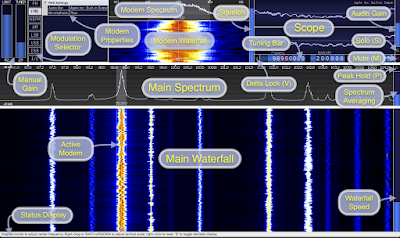Apparently, PSKReporter is now able to tell us not only where our signals did get to in the recent past, but where they will get to in the future!
This morning, the site showed that I would be received, 54 minutes in the future, by DL0PF, at -14dB!
 |
| PSKREporter's new 'Where you will be heard' feature. |
Well, as it happens, this opens up thoughts of Wheeler-Feynman
Absorber Theory (more recently developed into the '
Transactional Interpretation' of quantum mechanics), which posits that, at the quantum level, the equations of physics are time-symmetric.
This is actually very thought-provoking in terms of our use of radio. Under the Transactional Interpretaion (TI), we place ourselves in an external 'pseudo' time to understand what is happening between an emitter and an absorber (or, a transmitting antenna and a receiving one).
In very simple terms, TI says that an emitter sends a wave symmetrically, into the future and the past. The future wave meets an absorber somewhere in the Universe.
The absorber, in turn, sends an 'acknowledgement' wave back down the path of the original 'future' wave, into the 'past', and also into its future.
Everywhere in the Universe, except for the direct path between emitter and absorber, the waves cancel out. Between the emitter and absorber, a reinforcment of waves - a 'handshake' - develops that forms what we understand as reality.
 |
| The basics of Absorber Theory/TI, as conceived in 'pseudo time'. |
If you think this is nuts,it really isn't. Spend some time reading about it online, or in books, especially John Gribbin's
Schrodinger's Kittens and (much more mathematically) John Cramer's
The Quantum Handshake. That way, you will see how TI resolves all those endless 'problems' of non-locality and how particles an arbitrarily large distance away from one another can, nevertheless, instantly communicate their state between them. No need for the ludicrous ideas of the 'Copenhagen Interpretation', which anyone with half a brain can see is a load of rubbish.
One way to think about this is from the photon's point of view. Travelling at the speed of light, Lorentz contraction means it experiences no distance and no time: it can be everywhere, at all times. You can even devlop an argument (as
John Wheeler did), that there is only one (in this case, electron) in the Unvierse!
Actually, Wheeler's idea is not true, because if there were only one electron in the Universe, it couldn't be absorbed and could, therefore, not emit. Experiments with radio telescopes to try and detect a lack of absorbers in certain directions have actually been conducted, and confirm there is no such lack of absorbers. If there was, the radio telescope would 'refuse' to transmit in those directions.
Anyhow, in our frame of reference, where we move through space hardly at all, but move through time at essentially the speed of light, time seems real enough. But in another frame of reference, the antenna receiving your signal 'knows' you will send it (in your frame of reference)
before you transmit it!
You can also branch out from here into the fascinating world started a long time ago with Kaluza-Klein theory, where the forces of nature combine in one, large matrix known as the Riemann metric tensor (much easier to understand than it sounds - try Michio Kaku's
Hyperspace).
With this set of ideas more recently developed into string theory, we can understand electromagnetism in our four spacetime dimensions as the rippling of gravity in the fifth dimension. That's quite a thought to have, as you look at your antenna through the window!
As Plato said in his Allegory of the Cave, "Earthly knowledge is but shadow". Your head may hurt, but in a nice way...
















































